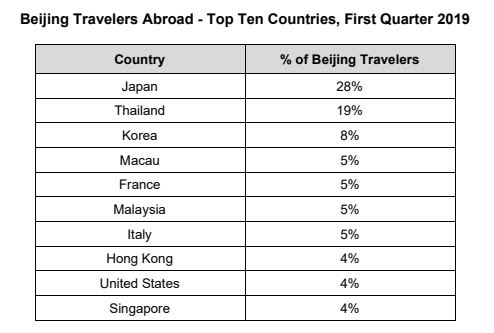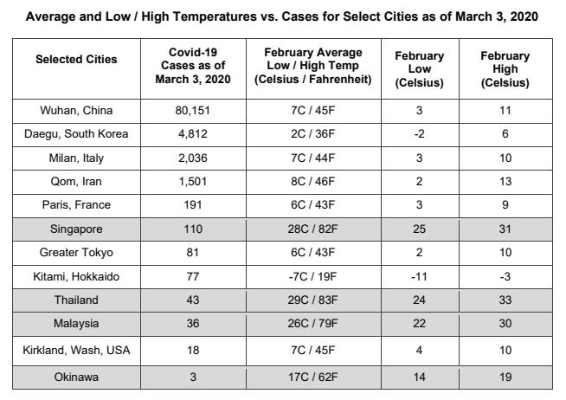Will Coronavirus (Covid-19) Weaken In Springtime In The Northern Hemisphere?
A group of consultants at Azabu Insights Inc., a strategic consulting company in Azabu Juban Tokyo, have been analyzing data to understand the correlation between air temperature and spread of the coronavirus (Covid-19). We wondered if the coronavirus was spreading more widely in colder climates and if this suggests some respite in the warmer months for the northern hemisphere.


Our team members came up with the hypotheses when looking at lists of countries and regions with the most affected patients. We compared this to our "expectations" of most affected areas based on our understanding of where we saw large numbers of travelers from China. This was later backed up by travel data.
Within Japan we noticed large outbreaks in Hokkaido (Japan's most northern and very cold island) and very few outbreaks in Okinawa (Japan's subtropical southern island). Okinawa is a place that one might have expected to see a large outbreak as we knew that the Diamond Princess cruise ship docked there and many passengers got off the ship on February 1st. However, only three cases have been found in Okinawa, where the average temperature in February is 17 degrees Celsius. On the other hand in Hokkaido, where the average temperature in the outbreak epicenter of Kitami was -7 degrees Celsius in February, there have been seventy-seven cases (as of March 3, 2020).
Hokkaido and Okinawa are comparable in other ways. Both Hokkaido and Okinawa have large numbers of Chinese travelers. Both are comparatively more reliant on car travel than much of the rest of Japan. And while Hokkaido has a larger population of 5.3m compared with Okinawa's 1.5m, Hokkaido's much larger area leads to Okinawa having a much higher population density at 640/km2 versus Hokkaido's 63 persons/km2.
From a business perspective they are also similar in having multiple listed companies related to banking, power, and cellular. Hokkaido has many more listed companies, however, with broader offerings that include retail, food, service, and others. Hokkaido is also home to the Sapporo Securities Exchange (SSE) and Ambitious (AMB).
Okinawa's listed companies include: The Bank of Okinawa Ltd. (TSE1: 8397); Bank of the Ryukyus, Limited (TSE1: 8399); Okinawa Electric Power Company (TSE1: 9511), Okinawa Cellular Telephone Company (JASDAQ: 9436), SAN-A Co., Ltd. (TSE1: 2659). Hokkaido listed companies include: Hokkaido Electric Power (TSE1: 9509), Kanamoto Co., Ltd. (TSE1: 9678), Sapporo Clinical Laboratory (JASDAQ: 9776), CE Holdings (TSE1: 4320), as well many others.
Looking at a country level we saw a similar relationship between cold weather and high infections. We first examined the three countries where Beijing travelers are said to travel most frequently: Japan, Thailand, and Korea. Although 19% of Beijing tourists travelled to Thailand (data from first quarter 2019), there were just 43 cases of Covid-19 confirmed. In contrast, Japan has 980 confirmed cases (including the Diamond Princess). Korea had more than 10 times more cases (4,812) despite having less than half the Chinese tourists that Thailand sees.
For reference refer to table 1 of Beijing tourists, and table 2 of temperatures in selected countries.
Looking at other regions where outbreaks have occurred also seemed to indicate a similar correlation of cold temperatures to high numbers of infections. The six cold regions that we analyzed had comparatively high outbreak numbers while the four warm regions had lower numbers compared to our expectations based on movement patterns of Chinese travelers.
In table 2 one can see that the cold areas of Wuhan, South Korea, Italy, Iran, France, Tokyo, Hokkaido all have fairly high numbers compared to expectations. The warm regions, including Singapore, Thailand, Malaysia and Okinawa all had fairly small numbers compared to expectations. Washington State would also be considered cold and news articles suggest that the outbreak may be growing faster than the current confirmed count would suggest.
Our researchers acknowledged that such a small sample size of regions does not provide statistical significance. Yet, we believe that starting to see patterns may be helpful in understanding the virus spread.
Are we suggesting that the virus cannot not spread in warmer clients? Certainly not. There have been at least 500 confirmed cases (as of March 3, 2020) in warm climates. However, there have been many more in colder climates with 10,178 (excluding Wuhan). This number would reach 90,329 if Wuhan cases were counted.
Data on the longevity of the virus on surfaces in different temperatures provides support to our hypotheses. A study published in the Canadian Journal of Microbiology referring to a different coronavirus (coronavirus 229) stated, "viral infectivity was completely lost after a 14-day incubation period at 22, 33, or 37 degrees C but remained relatively constant at 4 degrees C for the same length of time." This again indicates that colder temperatures support the virus better.
Additionally, studies conducted by Ruhr University Bochum and the University of Greifswald indicated that some coronaviruses could survive on surfaces for 28 days or longer at 4 degrees Celsius; in warmer temperatures coronaviruses ceased to be persistent after only a few hours or days.
This does not indicate that infections spread more from surface contact, which we have not studied. But it does suggest that the virus has less ability to survive in warmer climates.
Does all of this suggest that the Coronavirus will absolutely go away in spring? We think not. Based on the data showing spread, albeit at a slower pace, in warm climates, we believe people will continue to be infected. However, it might suggest that if communities continue to make the right decisions about virus control, they might get a positive boost from warmer weather come spring and summer.


 NZ Film Commission: Kiwi Film Tinā Opens Over $1m, Striking A Collective Chord Across Aotearoa
NZ Film Commission: Kiwi Film Tinā Opens Over $1m, Striking A Collective Chord Across Aotearoa PPTA Te Wehengarua: No Frills Teaching Council Needed
PPTA Te Wehengarua: No Frills Teaching Council Needed Brainfit: Brain Health Wake-Up Call - Simple Advice From NZ Memory Experts For Brain Awareness Month In March
Brainfit: Brain Health Wake-Up Call - Simple Advice From NZ Memory Experts For Brain Awareness Month In March  Ockham New Zealand Book Awards: 2025 Finalists Announcement
Ockham New Zealand Book Awards: 2025 Finalists Announcement NZEI Te Riu Roa: Call For Education Minister Erica Stanford To Take Over School Lunches Programme
NZEI Te Riu Roa: Call For Education Minister Erica Stanford To Take Over School Lunches Programme Office of the Ombudsman: Chief Ombudsman Releases Report Into Secure Aged Care Facilities
Office of the Ombudsman: Chief Ombudsman Releases Report Into Secure Aged Care Facilities